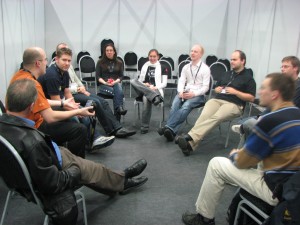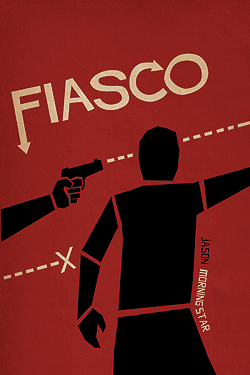[This is the second part in a multi-part series examining how uncertainty works in an analog role-playing context. The first part can be found here.]
To design any game within a culture means controlling different aspects of socially experienced “uncertainty” within the game. As George Elias, Richard Garfield and Robert Gutschera write: “[If] we had to pick one ingredient that was necessary (although not sufficient) for something to be a game, uncertainty in outcome would probably be it.”1 Because of that concept’s inherent “slipperiness,”2 however, few game designers discuss uncertainty beyond the level of card/dice probabilities and the use of secrets/hidden information. But now Greg Costikyan has written a book detailing how uncertainty might be used a tool to ask the straightforward question: how does this particular RPG work? This essay uses his language of procedurality to describe disparate RPGs in compatible terms. This method allows me to describe the tensions inherent in RPGs that highlight their most game-like features.

Costikyan identifies eleven forms of uncertainty, each centering on a specific question. Bear with me – we’ll need these terms later: performative uncertainty (“Will I be able to physically execute this maneuver?”), solver’s uncertainty (“Can I solve the puzzle here?”), player unpredictability (“How is my play experience contingent on the actions of others?”), randomness (“What will fortune give me?”), analytic complexity (“What decision will I make, given this complex decision tree?”), hidden information(“What information is being deliberately withheld?”), narrative anticipation(“What’s going to happen next?”), development anticipation (“What new additions/releases will the publisher make?”), schedule uncertainty(“When will I next be able to return to this game?”), uncertainty of perception(“How can I filter out certain data to perceive the important data?”) and semiotic uncertainty(“What will my playing this game mean?”).

Most games dovetail two different primary forms of uncertainty to generate tension. For example, Dimitry Davidoff’s ever-popular party game Werewolf, also known as Mafia, uses player unpredictability and hidden information to drive the game forward. We as players aren’t really interested whether or not we’re capable of playing the game (performative uncertainty) or whether or not Davidoff will introduce a new variant of the game while we’re playing it (development anticipation), but we are super-invested in A) anticipating other players’ behavior and B) judiciously hiding or figuring out who’s killing all the innocent civilians. Without both sets of activities, Werewolf would be a rather boring game.
Games often appear to hold one form of uncertainty in high regard, but will then reveal through play the dovetailed forms of uncertainty that actually drive the game. The old Sierra King’s Quest adventure games for the PC were ostensibly about “the story” (narrative anticipation), but actually leaned heavily on solver’s uncertainty (i.e., using the right objects in the right way at the right time) and uncertainty of perception (i.e., locating said objects in the game’s artwork, see also “pixel-bitching”).3 Such a move led to the adventure genre’s eventual decline and rebirth through the “hidden object” genre. The Settlers of Catan board game is ostensibly concerned with a player’s strategy for winning (analytic complexity), whereas actual gameplay reveals an overt focus on randomness (how the dice determine availability of resources) and player uncertainty (how much players are willing to trade for the resources in play).

Analog role-playing games prove interesting as an uncertainty-generating platform because they often have extremely mutable game-states, based on the players interaction with the system and their interpretations thereof. One of the objectives of The Forge, a now-defunct RPG design forum, was to get designers to clarify how exactly their rules were producing such game-states, moving beyond the uncertainty a given game promised to its players – usually some combination of narrative anticipation, randomness, narrative anticipation, and player uncertainty – and the uncertainties the game actually delivered to its players.4 This tension between promise and product belongs to most role-playing games, but few designers couch it in broader terms (e.g., uncertainty) beyond the narrow confines of their conception of “system” (e.g., the use of dice, cards, stats, narration, etc.) Below, I draw on rules texts and my own experiences with the games in question to discuss how the design deploys various forms of uncertainty.

The role-playing game everyone thinks of when one says “role-playing game,” Dungeons & Dragons (1973; 2014) promises “story” (narrative anticipation) as well as a reliable set of rules to arbitrate outcomes (randomness) in that story. To quote the recently published D&D basic rules: “The Dungeons & Dragons roleplaying [sic] game is about storytelling in worlds of swords and sorcery. … Unlike a game of make-believe, D&D gives structure to the stories, a way of determining the consequences of the adventurers’ action. Players roll dice to resolve whether their attacks hit or miss or whether their adventurers can scale a cliff, roll away from the strike of a magical lightning bolt, or pull off some other dangerous task. Anything is possible, but the dice make some outcomes more probable than others.”5 In fact, rather than primarily focusing on narrative anticipation or randomness, editions of Dungeons & Dragons usually rely on analytic complexity to help players skew randomness in order to properly address the hidden information and solver’s uncertainty in store for the player-characters. In simpler terms: the D&D rules emphasize the myriad skills, tools and abilities the player-characters have at their disposal to confront the dungeonmaster’s calculated threats and puzzles sitting behind the DM’s screen. There are known unknowns that one plans for, but also unknown unknowns. There is also some development anticipation, as new editions and modules for the game affect long-term campaign play. Player-characters arm themselves against uncertainty itself. Nevertheless, the development anticipation of D&D is actually the most existential form of uncertainty because it’s precisely the aspect of the game over which the player has the least control.

Jason Morningstar’s Fiasco (2008) is a game that simulates the disastrous consequences of small-time capers, à la the cinema of Joel and Ethan Coen. The cover states that it is a game about characters with “powerful ambitions and poor impulse control,” suggesting that – wherever the narrative may go – it will surely be a fiasco. Since the players already know this going in, narrative anticipation is somewhat substituted with semiotic uncertainty: we know the situation will go south, but how and what will it mean? The game itself, however, primarily functions on player uncertainty and narrative anticipation, with just enough randomness thrown in (along with the barest minimum of analytic complexity via the playsets)6 so that the players feel like there is some input from “outside” the table. This has the effect of giving a group of random players immediate creative seeds that they felt like they chose (via the playset), and then puts them in a position in which they’re mostly just sorting out the story among themselves. The randomness and analytic complexity are just alibis for gamers to engage seriously with each other as their own randomizing elements. Dungeons & Dragons, by contrast, deploys narrative anticipation and randomness as an alibi to engage seriously with its idiosyncratic system of character tweaks upon creation and leveling up.

Erick Wujcik’s Amber Diceless Roleplaying promises fiction similar to that of Roger Zelazny’s Chronicles of Amber book series: a bitter family of gods and goddesses squabbling over the substance of reality itself. One might argue that this diceless system contains the least uncertainty of the games discussed, for uncertainty is often associated with the randomness contained within dice probability charts. Costikyan’s taxonomy reveals this to be mere cultural bias, however. The game promises narrative anticipation but actually delivers one of the most finely honed marriages between player uncertainty and hidden information in gaming. Players create their characters by bidding points against the other characters, creating surprising antagonisms among the player-characters that emerge. No one knows how a player will commit their points, and characters then exist for the rest of the campaign in power relationships only with each other. Player-characters are encouraged to hatch secret plots against each other to advance their own agendas.7 Though the game rewards you for creating your character’s backstory or drawing his/her/their picture, it casts this delicate creation into the thorny intrigues of both the gamemaster and your fellow player-characters. Dice and the randomness they bring with them thus create a kind of comfortable alibi for consequences within a game; remove them, and you have only the fickleness and caprices of other human beings to which you can attribute game and story outcomes.8 Compared to Fiasco or Dungeons & Dragons, hidden information and player unpredictability encourage Poker-like bluff-and-risk play cycles without cards or dice.

Speaking of games of discomfort, Epidiah Ravachol’s horror RPG Dread famously uses a Jenga tower to help pace the characters’ slow descent into the abyss. Horror draws on fear of the unknown (hidden information) and the question “What’s going to happen?” (narrative anticipation), but the game itself actually pivots on performative uncertainty: the players’ ability to pull Jenga blocks from the tower without making it collapse. If you make the tower collapse, your character dies. Nevertheless, the character questionnaires that players must initially complete provide some measure of player unpredictability – not even the gamemaster can predict the players’ responses – while the act of knocking over the tower provides a kill-switch to all the uncertainty: you get to sacrifice your character to determine vital narrative details. This has the effect of binding the physical act of confronting the tower with narrative anticipation, binding both emotional uncertainties into a kind of feedback loop. Although diceless like Amber, hidden information takes a backseat to these two other uncertainties, which then drive play akin to a video game: if you complete the physical challenge, you get to see more story.
[With] a rubric of uncertainty, we just might find a common language that underwrites all RPGs and, with it, the underlying principles that make them work in a social context.
As you can see, Costikyan’s method provides us with insight into game design decisions and player incentives with minimal discussion of genre, artistic intent or other tried-and-true taxonomies. There are issues with this, of course. Genre tropes play a much-underrated role in the formation of the unwritten social contracts that drive the fiction. Agreeing that our characters are going on three awkward dates – as in Emily Care Boss’ Breaking the Ice – may do more to establish expectations of play than anticipation of individual player actions. Artistic intent allows us to interface a hypothetical authorial goal with the outcomes of the game. Nathan Paoletta’s carry says it focuses “more on dealing with [how soldiers behave in war] than on celebrating violence or exploring tactical and strategic choices,”9 and indeed we as players can then specifically deploy the rules toward that shared purpose. Categorizing players and creative agendas (i.e., GNS)10 gives us the tools discern overarching patterns in individuals and systems alike. But with a rubric of uncertainty, we just might find a common language that underwrites all RPGs and, with it, the underlying principles that make them work in a social context.
–
Featured image CC BY ioana @Flickr.
–
Experimentation and Design editor, Evan Torner, PhD (University of Massachusetts Amherst), is Assistant Professor of German Studies at the University of Cincinnati. His dissertation “The Race-Time Continuum: Race Projection in DEFA Genre Cinema” explores East German westerns, musicals and science fiction in terms of their representation of the Global South and its place in Marxist-Leninist historiography. This research has been supported by Fulbright and DEFA Foundation grants, as well as an Andrew W. Mellon Postdoctoral Fellowship at Grinnell College from 2013-14. His fields of expertise include East German genre cinema, German film history, critical race theory, and science fiction. His secondary fields of expertise include role-playing game studies, Nordic larp, cultural criticism, electronic music and second-language pedagogy. Torner has contributed to the field of game studies by way of his co-edited volume (with William J. White) entitled Immersive Gameplay: Essays on Role-Playing and Participatory Media (McFarland, 2012). He organized the Pioneer Valley Game Studies Colloquium in 2012, and helps organize JiffyCon, Origins Games on Demand, and Western Massachusetts Interactive Literature Society (WMILS) events. His freeform scenario “Metropolis” was nominated for “Best Game Devices” at Fastaval 2012 in Hobro, Denmark, and several other scenarios have been selected for the program. These scenarios constitute part of a larger book project that teaches German cinema through the medium of live-action games. He has also written prose for the Knutepunkt books as well as Playground magazine. He can be reached at evan.torner <at> gmail.com.


2 thoughts on “Uncertainty in Analog Role-Playing Games, Part 2”
Comments are closed.